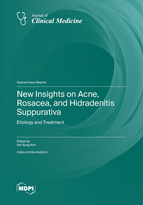New Insights on Acne, Rosacea, and Hidradenitis Suppurativa: Etiology and Treatment
A special issue of Journal of Clinical Medicine (ISSN 2077-0383). This special issue belongs to the section "Dermatology".
Deadline for manuscript submissions: closed (20 March 2023) | Viewed by 55933
Special Issue Editor
Special Issue Information
Dear Colleagues,
Acne, rosacea, and hidradenitis suppurativa (formerly called acne inversa) are skin diseases which share similar features such as redness, papules, nodules. All can result in reduced self-esteem, anxiety, and depression.
With the recent advent of molecular biology and next-generation sequencing (NGS), knowledge on the skin microbiota in these skin conditions has grown exponentially. Additionally, the potential involvement of insulin-like growth factor (IGF)-1 has been suggested in acne, rosacea and hidradenitis suppurativa which opens the possibility for new treatment. Biologics and JAK-inhibitors are also a promising option and should be further examined.
We herein welcome papers which provide exciting new insights on acne, rosacea, and hidradenitis suppurativa.
Prof. Dr. Hei Kim
Guest Editor
Manuscript Submission Information
Manuscripts should be submitted online at www.mdpi.com by registering and logging in to this website. Once you are registered, click here to go to the submission form. Manuscripts can be submitted until the deadline. All submissions that pass pre-check are peer-reviewed. Accepted papers will be published continuously in the journal (as soon as accepted) and will be listed together on the special issue website. Research articles, review articles as well as short communications are invited. For planned papers, a title and short abstract (about 100 words) can be sent to the Editorial Office for announcement on this website.
Submitted manuscripts should not have been published previously, nor be under consideration for publication elsewhere (except conference proceedings papers). All manuscripts are thoroughly refereed through a single-blind peer-review process. A guide for authors and other relevant information for submission of manuscripts is available on the Instructions for Authors page. Journal of Clinical Medicine is an international peer-reviewed open access semimonthly journal published by MDPI.
Please visit the Instructions for Authors page before submitting a manuscript. The Article Processing Charge (APC) for publication in this open access journal is 2600 CHF (Swiss Francs). Submitted papers should be well formatted and use good English. Authors may use MDPI's English editing service prior to publication or during author revisions.
Keywords
- acne
- rosacea
- hidradenitis suppurativa
- new insights
- etiology
- treatment
- skin microbiome
- IGF-1







